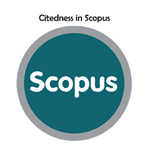Uji Aktivitas Antioksidan Minyak Argan (Argania spinosa L.) Dalam Bentuk Sediaan Mikroemulsi
Abstract
Keywords
Full Text:
PDFReferences
Yadav, A. Kumari, R., Yadav, A., Mishra, J. P., Srivatva, S. & Prabha, S. (2016). Antioxidants and its functions in human body - A Review. Research in Environment and Life Sciences. Vol 9
Guillaume, D. dan Charrour, Z. (2011). Argan Oil. Medicine Review. Vol 16
Kamal, R., Kharbach, M., Imig, J. D., Eljmeli, M., Doukkali, Z., Mrabti, H. N., Elmsellem, H., Bouklouze, A., Cherrah, Y., Alaoui, K., (2017). Antioxidant activities, total polyphenolic compounds and HPLC/DAD/MS phenolic profile of argan oil derived from two different methods of extractions. Journal of Materials and Environmental Sciences. Vol 8
Chansakaow, S. Sirisa-Ard, P. dan Khonkarn, R. (2017). Preparation, Characterization And Antioxidant Activity Of Xanthone-Loaded Making (Hodgsonia Heteroclita) Microemulsions. International Journal Of Pharmacy And Pharmaceutical Sciences. Vol 9
Kumar, K. S., Dhachinamoorthi, D., Saravanan, R., Gopal, U. K. dan Shanmugam, V. Microemulsions As Carrier For Novel Drug Delivery: A Review. International Journal of Pharmaceutical Sciences Review and Research. Vol 10
Rowe, R.C., Paul J. Sheskey , dan Marian E Quinn. 2009. Handbook Of
Pharmaceutical Excipients. Sixth Edition. Pharmaceutical Press: London
Sulastri, E., Oktaviani, C. dan Yusriadi. 2015. Formulasi Mikroemulsi Ekstrak Bawang Hutan dan Uji Aktivitas Antioksidan. Jurnal Pharmascience. Vol 2
Martin, A., James, S. dan Arthur, C. 1993. Farmasi Fisik: Dasar-dasar Farmasi Fisik dalam Ilmu Farmasetik. UI Press: Jakarta
Pamudji, J. S., Darijanto, S. T. dan Rosa, S. 2012. Formulasi dan Evaluasi Mikroemulsi Minyak dalam Air Betametason 17-Valerat. Acta Pharmaceutica Indonesia. Vol 38
Hasrawati, A., Hasyim, N. dan Irsyad, N. A. 2012. Pengembangan Formulasi Mikroemulsi Minyak Sereh (Cymbopogon nardus) Menggunakan Emulgator Surfaktan Nonionik. Jurnal Fitofarmaka Indonesia. Vol. 3 No.1
Lachman, L. Lieberman, H. A. dan Kanig, J. L. 1976. The Theory and Practice of Industrial Pharmacy. Lea and Febiger. Philadelphia
Vadas, E. B. 2000. Stability of Pharmaceutical Products, dalam Gennaro, A. R.
Remington : The Sciences and Practice of Pharmacy, 20 th edition Jilid I. Philladelphia College of Pharmacy and Sciences
Danimayostu, A. A., Shofiana, N. M. dan Permatasari, D. 2017. Pengaruh Penggunaan Pati Kentang (Solanum tuberosum) Termodifikasi AsetilasiOksidasi sebagai Gelling agent terhadap Stabilitas Gel Natrium Diklofenak. Pharmaceutical Journal Of Indonesia. Vol 3(1)
Sinko, P. J. 2006. Martin's Physical Pharmacy and Pharmaceutical Sciens Fifth Edition. Lippicott Wiliams & Wilkins. Philadelphia
Fitriani, E. W., Imelda, E., Kornelis, C. dan Avanti, C. 2016. Karakterisasi dan Stabilitas Fisik Mikroemulsi Tipe A/M dengan Berbagai Fase Minyak. Pharm Sci Res. Vol 3
El-Abbassi, A., Neves, M. A., Kobayashi, I., Hafidi, A. dan Nakajima, M., 2013. Preparation and characterization of highly stable monodisperse argan oil-in-water emulsions using microchannel emulsification. Europe Journal Lipid Science Technology. Vol 115
Badarinath, A., Rao, K., Chetty, CS., Ramkanth, S., Rajan, T. dan Gnanaprakash, K. 2010. A Review on In-vitro Antioxidant Methods : Comparisons, Correlations, and Considerations. International Journal of PharmTech Research.
DOI: https://doi.org/10.37311/ijpe.v1i1.9951
Refbacks
- There are currently no refbacks.
Copyright (c) 2021 Nur Ain Thomas, Juliyanty Akuba, Mohammad Adam Mustapa, Adiva Sidangoli

Indonesian Journal of Pharmaceutical Education is licensed under a Creative Commons Attribution-NonCommercial-ShareAlike 4.0 International License.



